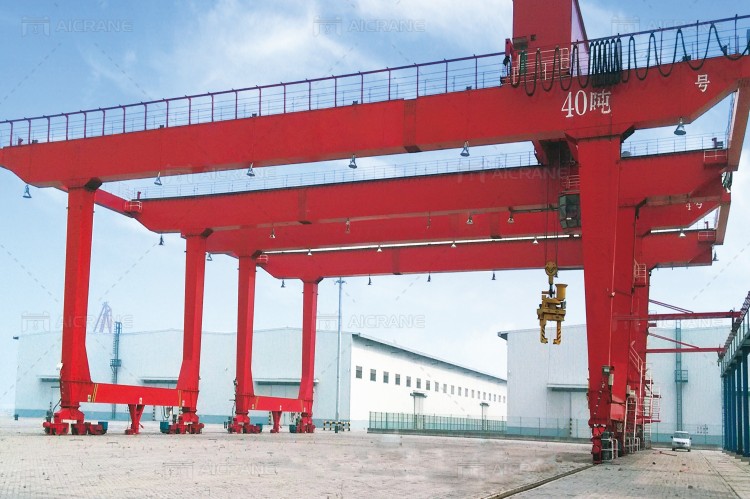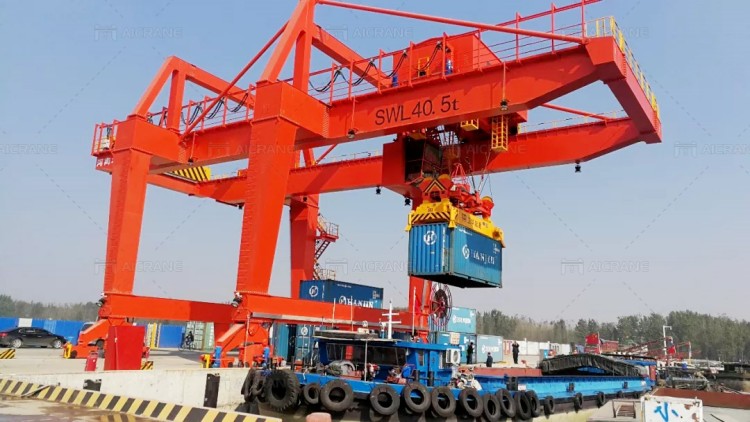RMG (Rail Mounted Gantry) container cranes are specialized lifting machines used in ports, container terminals, and intermodal yards for efficient handling of shipping containers. These cranes operate on rails, providing a high level of stability and precision in container handling operations. In this article, we will explore the applications, selection criteria, inspection procedures, and maintenance considerations for RMG container cranes.
Applications of RMG Container Cranes
RMG container cranes are primarily used in container terminals and ports for various handling tasks, including:
Container Stacking: RMG cranes excel in stacking containers in rows and blocks within a container yard. Their ability to reach multiple rows and stack containers in a well-organized manner maximizes space utilization.
Container Transfers: RMG cranes facilitate the transfer of containers between trucks, rail cars, and container vessels. They are capable of loading and unloading containers from ships efficiently and precisely.
Yard Management: RMG cranes play a crucial role in yard management operations, including container sorting, tracking, and inventory management. Their speed and accuracy in positioning containers contribute to streamlined operations and improved efficiency.

Selection Criteria for RMG Container Cranes
When selecting an RMG container crane, several factors should be considered to ensure the right equipment is chosen for the specific application. Key selection criteria include:
Load Capacity: Determine the maximum weight and size of containers to be handled. Select an RMG crane with an appropriate load capacity to accommodate the heaviest containers commonly encountered.
Span and Outreach: Consider the required span and outreach of the crane to effectively cover the container stacking area. Ensure that the crane’s span is sufficient to reach the desired number of container rows.
Rail Configuration: Assess the rail configuration of the container yard and determine whether a single or double girder crane design is more suitable. Double girder cranes offer higher lifting capacity but may require additional rail infrastructure.
Operating Environment: Evaluate the prevailing weather conditions, wind speeds, and seismic activity in the area. Select an RMG crane that is designed to withstand these conditions and ensure safe operation.

Inspection and Maintenance of RMG Container Cranes
Regular inspections and maintenance are essential to ensure the safe and efficient operation of RMG container cranes. Here are some important considerations:
Visual Inspections: Perform daily visual inspections of the crane, including structural components, rail system, electrical connections, and safety features. Look for any signs of damage, loose or worn parts, and ensure that safety devices, such as limit switches and emergency stop buttons, are functioning correctly.
Mechanical Components: Regularly inspect and lubricate the mechanical components of the crane, such as the hoist and trolley mechanisms, wheels, bearings, and wire ropes. Follow the manufacturer’s guidelines for lubrication intervals and use appropriate lubricants.
Electrical Systems: Inspect the electrical systems, including cables, connectors, control panels, and power supply. Check for any signs of wear, overheating, or loose connections. Conduct periodic electrical testing to ensure proper functioning and compliance with safety standards.
Structural Integrity: Monitor the structural integrity of the crane, including the main frame, gantry structure, and spreader beams. Look for any signs of corrosion, cracks, or deformations. If any issues are detected, consult the manufacturer or a qualified structural engineer for further assessment and necessary repairs.
Safety Devices and Controls: Test and verify the operation of safety devices, such as overload protection, anti-collision systems, and emergency stop mechanisms. Ensure that control systems, including operator consoles and remote control devices, are functioning correctly.
Operator Training: Provide comprehensive training to crane operators on proper operation, safety procedures, and emergency protocols. Regularly update their skills and knowledge to keep them informed about any new features or regulations.
RMG container cranes are vital assets in container terminals and ports, enabling efficient and reliable container handling operations. Proper selection, regular inspections, and proactive maintenance are crucial to ensure safe and efficient crane operation. By considering the applications, selection criteria, and implementing a comprehensive inspection and maintenance program, operators can maximize the lifespan of their RMG container cranes and optimize productivity in container handling operations. For more information about crane types and selection, it is advised to visit this ellsencranes.com/.